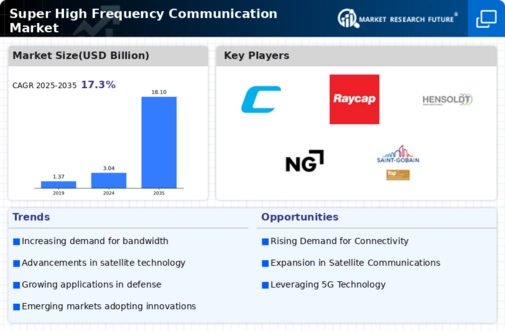Expansion of 5G Networks
The rollout of 5G networks is significantly influencing the Super High Frequency Communication Market. With the promise of enhanced data speeds and reduced latency, 5G technology is expected to revolutionize communication systems. By 2025, it is projected that 5G subscriptions will surpass 1.5 billion, driving the need for super high frequency communication solutions. This expansion not only facilitates faster mobile broadband but also supports a myriad of applications, including augmented reality and virtual reality. As telecommunications companies invest heavily in infrastructure to support 5G, the Super High Frequency Communication Market stands to benefit from increased demand for compatible communication technologies. The integration of super high frequency communication with 5G networks may lead to innovative applications and services, further propelling market growth.
Increased Adoption of IoT Devices
The proliferation of Internet of Things (IoT) devices is a key driver for the Super High Frequency Communication Market. As more devices become interconnected, the demand for high-speed communication channels intensifies. In 2025, it is estimated that there will be over 30 billion IoT devices in use, necessitating robust communication infrastructure. This surge in IoT adoption is likely to push the boundaries of existing communication technologies, thereby creating opportunities for advancements in super high frequency communication. The need for real-time data transmission and low latency in applications such as smart cities and autonomous vehicles further emphasizes the importance of this market. Consequently, the Super High Frequency Communication Market is poised for substantial growth as it adapts to the evolving landscape of IoT connectivity.
Rising Demand for Secure Communication
In an era where data breaches and cyber threats are prevalent, the demand for secure communication channels is escalating. The Super High Frequency Communication Market is responding to this need by developing advanced encryption and security protocols. Organizations across various sectors, including finance and healthcare, are increasingly prioritizing secure communication to protect sensitive information. The market for secure communication solutions is projected to grow at a compound annual growth rate of 12% through 2025. This trend indicates a robust opportunity for the Super High Frequency Communication Market to innovate and provide secure communication solutions that meet regulatory requirements and enhance user trust. As security becomes a paramount concern, the integration of super high frequency communication technologies with advanced security measures is likely to become a focal point for market players.
Advancements in Satellite Communication
Recent advancements in satellite communication technology are significantly impacting the Super High Frequency Communication Market. The increasing reliance on satellite systems for global communication, navigation, and data services is creating a demand for super high frequency communication solutions. By 2025, the satellite communication market is projected to exceed 150 billion, driven by applications in various sectors, including defense, telecommunications, and broadcasting. The ability of super high frequency communication to provide high bandwidth and reliable connectivity is essential for these applications. As satellite technology continues to evolve, the Super High Frequency Communication Market is likely to experience growth opportunities through partnerships and innovations that enhance satellite communication capabilities.
Emergence of Smart Transportation Systems
The development of smart transportation systems is driving the Super High Frequency Communication Market. As urban areas become more congested, the need for efficient transportation solutions is paramount. Super high frequency communication technologies are essential for real-time data exchange between vehicles, infrastructure, and traffic management systems. By 2025, the smart transportation market is expected to reach a valuation of over 200 billion, highlighting the potential for super high frequency communication to play a critical role in this sector. The integration of these technologies can enhance traffic flow, reduce accidents, and improve overall transportation efficiency. Consequently, the Super High Frequency Communication Market is likely to see increased investment and innovation as it aligns with the growing demand for smart transportation solutions.


















Leave a Comment